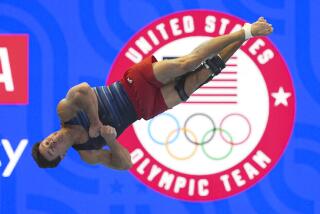Moscow Circus High Fliers Take Their Job Seriously : Aerialists: The Flying Cranes view their trapeze performance as a dangerous but poetic work of art.
- Share via
The Flying Vazquez Brothers, Ringling Brothers and Barnum & Bailey Circus’ star attraction, are one of the two acts in the world to perform trapeze’s ultimate accomplishment, the quadruple somersault. But, before Miguel and Juan Vazquez attempt this difficult maneuver, the lights dim, the circus ringmaster grabs a microphone and tells the audience what is about to transpire--”Drum roll, please!”--all in attempts to dramatize the trick.
The Moscow Circus’ Flying Cranes, now appearing at the San Diego Sports Arena for a five-day run, also perform the quadruple somersault. They do so, however, without the gratuitous theatricality, .
“What we’re trying to do is not a bunch of tricks,” said Vilen Golovko, 34, leader, spokesperson and catcher for the Flying Cranes. “We’re trying to perform something and give a meaning to it. We’re not interested in announcing records or achievements.
“It’s like Baryshnikov,” he continued, speaking through an interpreter. “When he was dancing, he didn’t announce to the public: ‘Now, I will attempt a quadruple pirouette.’ Neither do we.”
Instead, the Cranes strive to tell a poetic story with their distinct, haunting aerial ballet.
The Cranes routine, which features precise choreography and elaborate mechanical devices, documents the heroic spirit of Soviet soldiers killed during World War II. Trapeze artists depict soldiers falling in battle as they drop--intentionally--from incredible heights onto the net below. Later in the show, the fallen soldiers are plucked from the battlefield and their souls soar into the air, immortalized in memory.
The inspiration for the performance derives from “The Flying Cranes,” a ballad written by contemporary Soviet songwriter Russal Gamzatov:
“Soldiers who fought for us in terrifying war
They weren’t simply buried in bloody fields in pain
For their spirits flew up in the sky
Where they could soar
And they became all birds
The Flying Cranes”
In the Soviet Union, trapeze is considered an art form, much like theater and dance. Golovko considers his trapeze work a form of acting, and the Cranes’ magnificent performance last week at the Great Western Forum in Inglewood justifies the label.
Golovko, a lean, athletic type, discussed the Flying Cranes’ particular brand of artistry during intermission backstage. Through a stern expression and sleepy eyes (“We save all our energy during the show. Afterwards, we are completely drained”), Golovko focused on the Flying Cranes’ ongoing quest for perfection.
“When I perform, I’m thinking only about what I do, of laying out my part correctly,” Golovko said.
This is understandable, considering that featured aerialist Petr Serdukov explodes out of his multiple somersaults at breakneck speeds. Golovko, the catcher, quite literally holds Serdukov’s life in the balance night after night.
“We are a whole organism. The group depends on each other and the fliers depend on me.”
Danger aside, the Flying Cranes still press themselves to achieve greater heights, to further amaze audiences with athletic feats.
The troupe landed on North American shores last summer with a specific mission in mind: the quintuple somersault. The Cranes perfected the triple somersault years ago, mastered the quadruple somersault just recently, and were determined to attempt the never-before accomplished quintuple somersault--”the Five,” as they call it--at some point during this tour.
Struck by a series of minor, nagging injuries, the Flying Cranes will not be attempting “the Five” during this tour. According to Golovko, the troupe may not risk performing quadruple somersaults, either. The rationale is simple: The story comes first. Because the Cranes’ routine is choreographed to prerecorded music and preprogrammed lighting, the slightest miscue jeopardizes the show’s linear narrative.
“I don’t think we will do quadruples,” said Golovko, “because Petr (Serdukov) will not be well enough yet. During practice, he fell into the net on his (previously injured) shoulder. It’s like falling on your shoulder out of a seventh-floor window. If you don’t fall properly, then you can injure yourself very much.”
Golovko does not want the audience thinking about the safety of the individual performers as they watch the Cranes. In fact, he would prefer if audience members didn’t think at all.
“I would like the audience not to think, but to watch with emotion,” he said. “I’m more interested with how the audience feels.”
More to Read
The biggest entertainment stories
Get our big stories about Hollywood, film, television, music, arts, culture and more right in your inbox as soon as they publish.
You may occasionally receive promotional content from the Los Angeles Times.










